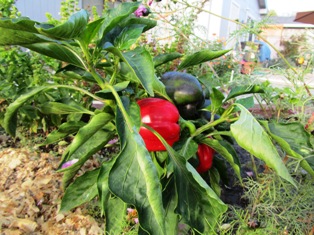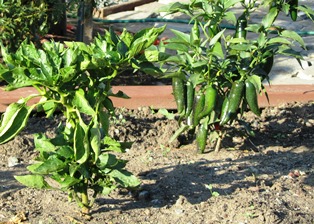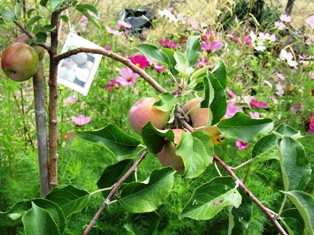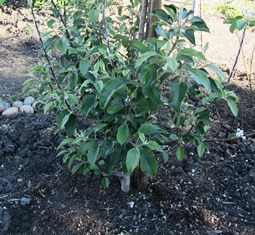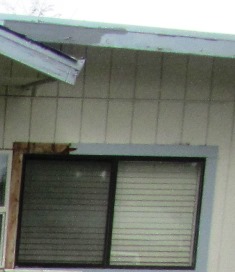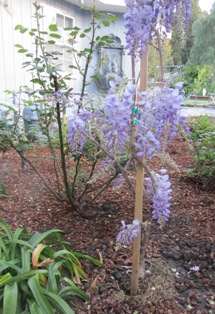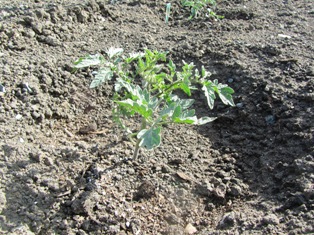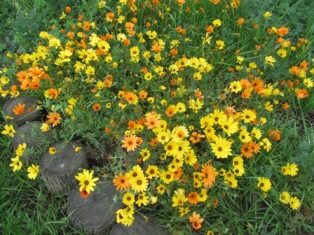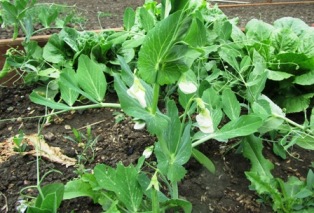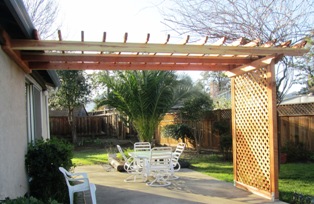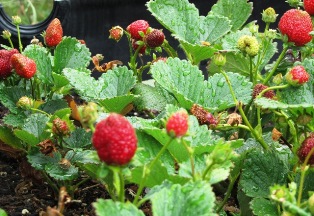Archive for the 'Gardening' Category
Learning about GMO Food Safety
You might assume your zucchini and sweet corn is safe to eat but what if it was grown from GMO-treated seed, able to withstand an herbicide or even produce an insecticide as it grows? What happens in your gut when you eat that corn? What happens to animals fed such corn? These are questions that scientists, doctors, consumers, food safety advocates, and environmentalists all grapple with in their concern about GMO food safety.
The Non-GMO Project is a nonprofit organization concerned with GMOs and food safety. It explains on its Web site that a genetically modified organism (GMO) is a plant or animal that has been “genetically engineered with DNA from bacteria, viruses, or other plants and animals.” That means it is an anomaly in nature as such experimental combining of genes of different species does not occur in traditional crossbreeding or in nature (http://www.nongmoproject.org/learn-more).
Consumers might not be getting all the facts of what is known and what science is discovering about the health concerns of many Americans eating foods that contain GMOs. Estimates suggest that 80 percent of U.S. processed foods contain GMOs, meaning millions of Americans are eating foods that might not be all that safe to consume. Research into links between GMO consumption and ill health are ongoing but already GMO-altered foods, whether plants or animals, are raising health concerns.
Seed suppliers say that interest in non-GMO corn seed is growing among farmers because of lower costs, better animal health, and higher yields as well as increasing disenchantment with genetically modified traits of GMO seed (http://www.non-gmoreport.com/articles/january2013/Demand-growing-for-non-GMO-corn-seed.php)
With summer on the horizon, many people are planting seeds or seedlings in their gardens or are anticipating the plentiful vegetables available at produce stands and in supermarkets. But read the labels on all those mounds of squash, tomatoes, peppers, and potatoes.
Potatoes and tomatoes are considered low-risk for GMOs by the Non-GMO Project, that is, those two vegetables are not currently being genetically engineered. Although many people might think wheat is a concern, the Non-GMO Project states that wheat is not now nor ever has been genetically engineered, unlike soy, cotton, sugar beets, alfalfa, canola, zucchini, and summer squash.
More than 60 countries, including most of the developed nations, have banned or restricted GMOs. The United States is the exception, allowing production and sale of such products to continue. Consumers, scientists, and environmentalists opposed to genetic manipulation of plants and animals say avoidance and boycott of such products are consumer choices even as legal battles against bio-tech giants and anti-GMO advocates move through the courts.
As for summer corn, the best option might be to grow your own from heirloom seed that has not been genetically maniuplated. Otherwise, buy corn certified as non-GMO or from sources that support organic farmers and food sources such as Whole Foods and other organic markets. Check out the offerings for seed at Seeds Now (http://www.seedsnow.com/pages/shop-all-seeds).
Experiment with New Varieties of Tomatoes and Peppers
Tomatoes are one of my favorite plants from the summer garden. So it’s not surprising that of all the seed catalogs that I get each spring, the Tomato Growers catalog is one of my favorites. It offers 60 full-color pages of mostly tomatoes, but also peppers and eggplant varieties, a listing of equipment and supplies (for example tomato strainers), and books for gardeners. See, http://www.tomatogrowers.com/
I voraciously read all the catalog copy about each type of tomato and pepper and then note the seeds I want to grow. Experimenting with different varieties enables me to experience new flavors, new textures, and other unique characteristics of each variety.
In early spring when my neighbors rush off to garden centers for seedling tomatoes shipped to local nurseries by growers, I begin the process of planting my tomato and pepper seed in cell flats. The flats remain in the warm kitchen until the plants have emerged and have four sets of leaves. Only then do I place them in the garden to allow them time to acclimatize (harden off).
Removing the plants from their cell packs, I plant the seedlings in a basin or hole with native soil mixed with chicken manure or vegetable food. In that basin, the tomatoes benefit from the warmth of the sun and deep watering after transplanting. I do not plant the peppers in basins.
Stressing the tomato plant by withholding water yields tomatoes higher in flavor but can reduce the size and quantity. Too much water, however, can leach nitrogen and other nutrients from the soil and cause the plant to produce lots of leaves but fewer blossoms and fruit.
Near the heat-loving tomatoes in my garden, I always tuck in a few bell peppers, pickling peppers, and hot chili peppers. The Serrano peppers are pungent like jalapeno peppers and measure roughly 5,000 Scoville units of heat. Other peppers such as the Trinidad Perfume and the Fooled You peppers have no heat but are prized as seasoning for dishes requiring peppers.
A word of caution about growing tomatoes. Don’t plant them in the same area of your garden more than three years in a row. Experts say move them around as tomatoes are heavy feeders and putting them in depleted soil or soil in which you’ve grown tomatoes that have become sick can infect your new plants.
If you are interested in the pros and cons of dry farming tomatoes (meaning reduced watering) for intensive flavor and higher sugar content, check out the interesting article on the Growing For Market newsletter. See, http://www.growingformarket.com/articles/Improve-tomato-flavor
Mulching Do’s and Don’ts
An area of the garden where we planted apple trees two years ago had become so overgrown with weeds that it required many hours of weeding.
Following the weeding, we added organic mulch. I like to create an area as large as the canopy of the tree around the base of the tree (free of any plants or weeds) so that I can easily feed and water our fruit trees throughout the growing season. Then I reapply the mulch.
Mulching with organic material makes it easier to prevent the germination of weeds, facilitate watering and feeding of the fruit trees, encourages the proliferation and activities of earthworms (good for improving the soil), and keeps the soil moist (reducing the amount of water needed).
When adding organic mulch to the top of the soil, the keep in mind the following tips.
1. Do dig in high-nitrogen products such as chicken manure, blood meal, or cottonseed meal into the soil around the plant or tree before layering atop the soil low-nitrogen mulch such as bark, wood chips, or decayed sawdust material.
2. Do pull mulch back from over bulbs and perennials in the spring to facilitate a faster start to their warming and growth cycle.
3. Be aware of snails and slugs that can hide in damp mulch. Try placing a layer of newspaper where you think the snails and slugs might be proliferating. Put the paper down on the soil at night and retrieve it before sunup when you can turn it over to see the pests clinging to it. Dispose of the newspaper in the garbage.
3. Don’t mulch too close to the stems of shrubs or trees s since wet mulch and cause stem rot; ensure that the mulch is at least an six inches away from a shrub stem or tree trunk.
4. Don’t pile mulch too deep; doing so encourages rodents such as voles, rats, and mice to use the mulch for nests.
Windows on the World
We’ve been updating our windows on the farmette house. The work recently triggered a memory of an incident involving windows at the start of the remodeling of my San Jose home years ago.
Back then, even before the architect had begun the drawings, I informed him I wanted lots of windows and even noted placement, size, and shape. The poor man hadn’t even drawn the walls yet! We had a good laugh over my exuberance.
Here on the farmette where I’m married to the architect, I recalled that memory while we were pulling out the single-paned windows and replacing them with more energy efficient, double-paned windows.
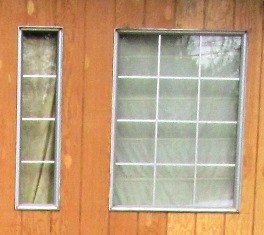
New windows can significantly transform the exterior appearance of the house as these as-yet-unframed ones demonstrate
The new windows will lower our energy bills and provide us with views of the world beyond the walls. From inside the house, I can look out and see my fairy garden (the Iceberg hybrid tea rose encircled in a mass planting of gray-green yarrow) and the blooms of purple and white irises in a circular planting around the almond tree. Once we’ve added trim and paint, the view outside in will be no less spectacular.
Spiffing up the Farmette for Easter
Finding inspiration in books I wrote long ago, I ‘ve been sprucing up the house and grounds in time for Easter weekend. Family and friends will be visiting. Rain has helped our roses to start blooming and the wisteria is manifesting gorgeous purple bracts in a new garden area where we’ve planted a dozen new rose bushes.
The richly woven linen-and-silk tablecloth I purchased at a sidewalk market in Greece (during the writing of my Everything Women of the Bible book) provides a formal look to the dining table. I added matching napkins and some vanilla- and mocha-colored candles in tall stemmed crystal holders to create a formal look.
In the living room against a raspberry colored wall, I positioned on the piano a pair of French style lamps with tall top hat shades. The ambiance of the informal but warm living room seems to invite conversation.

The Nyjer seed feeder beyond the kitchen window attracts finches while daffodils on the window sill cheer the cook
I love the greenhouse window in the kitchen but hanging a bird feeder outside reminds me (and my visitors) that here on the farmette, nature is never far away. Looking through the window from the kitchen got me thinking about flowers and floral patterns.
Years ago, I wrote a book titled, Blooming Rooms, with my friend and fellow writer A. Bronwyn Llewellyn. We divided up the writing of the chapters based on rooms of a house. She wrote the chapter on kitchens and one of her brilliant ideas was to decoupage a serving tray with antique flower seed packets. Thinking about that book inspired me to bring some flowers into my kitchen. I searched for a pretty vase, filled it with water, and plunge into it a fistful of daffodils.
Finally, I believe our little home sweet home is ready to receive company.
Gardening by the Moon
Birthdays come around every year, like perennials. Mine was yesterday.
It just might be the most fortuitous birthday I will ever have. Why? Because it fell on the second day of Holy Week, the first night of Passover, and a full moon night (according to Old Timers, the best lunar phase to plant). So . . . I planted a garden.
Pole beans, corn, vining tomatoes, and sweet garden peas supposedly germinate faster during a full moon because of geotropism (gravity’s effect on plants), or so say those who believe in planting by the moon. Old Timers say the beans will race up the poles if you time their planting in alignment with the lunar cycle of a full moon.
All I know is that when the last tomatoes were in, the light of that humongous moon was spilling over inch of the farmette. I plucked a sprig of lavender and lifted it to my noise to inhale its sweet, clear scent. I sank onto my garden swing and kicked off my clod hoppers. It was time to celebrate.
First Day of Spring Brings Rain and Wildflowers
Nothing says “Spring” more than showers and wildflowers, unless, of course, it’s lettuce and fresh peas. Here on the farmette today, we had them all. The wind blew through a shower of tropical moisture throughout the night and the sprinkles perked up the cool season vegetables growing in our garden.
This morning I discovered a patch of wildflowers blooming in riotous colors. In the grow boxes along one side of our property, the lettuces had swelled to into plump-and-ready-for-picking sizes. The sweet garden peas had set baby pods, and the onions were reaching skyward. I do hope the bulbs beneath the soil are swelling as well.
Spring is the best time of the year for new beginnings, new projects, and new plants. My spring vow? To grow something new that I’ve never grown before. I hope you will, too.
Building A Fence Brings Neighbors Together
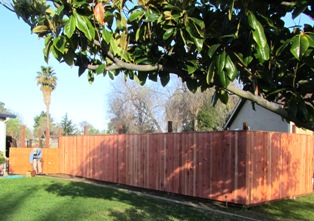
Carlos Carvajal, my architect-designer husband, near the fence we have been building for our neighbors
My husband is good at what he does. His highly developed aesthetic sense for design and sense of proportion and drive for perfection has proven invaluable in the projects he designs and builds. For the last two weeks, he’s been working one farmette over, replacing an old fence and crafting a trellis to support a gorgeous Japanese wisteria about to bloom.
I’ve been helping on the days he doesn’t have extra workers. Although I’ve helped him build fences on our property, the fence for our neighbors was a bit different. It would include supports for a lattice and would extend about 100 feet in length between the two properties.
Our neighbors are lovely and the building brought everyone together. We shared bottles of water and cups of juice, noonday meals, and lots of conversation. We worked through the weekend and since yesterday was Sunday, we even met extended family members who came to visit and to observe the fence building that was going on.
We shared a lovely Saturday lunch, thanks to the neighbors on one side of the fence and a beautiful Sunday lunch, gratis the neighbors on the other side of the fence. When the sun grew low on Sunday afternoon, yet another neighbor invited us over for a sumptuous meal of salad and grilled salmon. While the salmon cooked, we plucked two huge bunches of leaf lettuce from my garden and rolled lettuce leaves around slices of sheep’s milk cheese and sardines. The food went down perfectly with a central coast zinfandel from the Sterling vineyards.
I almost hate to have the fence building end. It’s been a wonderful experience to learn about the families living nearby and to share our love of our construction and gardening with them. In fact, it’s been the discussions about gardening that have proved for me most gratifying. I’ve enjoyed seeing their fruit trees in bloom and learning gardening tips they have shared.
Some people might believe that putting up fences hinders the fostering of neighborly relationships, but I’d have to say that it was the fence construction that helped us get to know our neighbors better.
Wisteria Adds Drama to an Arbor or Trellis
I love the look of an arbor or trellis that makes a classical architectural statement in the garden. My husband Carlos has built a few of these. Most recently, he created a lovely trellis to support a decades-old wisteria that a neighbor had been growing in her garden.
Wisteria is a deciduous vine, meaning it loses its leaves in the winter and goes dormant. These vines are long lived, can be quite thick in diameter, and have lovely bracts of flowers in the spring, even before they sprout leaves.
It’s best to purchase wisteria that has already been grafted onto root stock or that has been grown from a cutting. These vines aren’t particular about soil, but they do need plenty of water and good drainage.
The other requirements are pruning and training. Wisteria can grow as much as 20 to 30 feet during the first year. I had a plant in San Jose that climbed a trellis and spilled over onto the roof in its very first year in that location.
I like tying the vines and the streamers to support them. Wisterias can be trained as shrubs (albeit large ones) or even as small trees. If planted on a bank or berm, they can spread quickly to vigorously cover the area.
I grew Wisteria floribunda in my San Jose garden, but here I’ve chosen Wisteria senesis (Chinese Wisteria) for the Henny Penny Farmette patio arbor (that we have yet to install). Chinese Wisteria blooms all at once in a beautiful violet-blue color before it leafs out in April-May. The blooms, which are more spectacular than the Japanese wisteria, are only marginally fragrant.
There is another variety of wisteria–Wisteria venustra–known as silky wisteria. The flowers are very large, long-stalked, and white. The plant blooms in short, heavy clusters that open all at once. Leaves break open in April. Another cultivar–Wisteria violacea has purple-blue flowers that are quite fragrant.
If you already have an amazing trellis or arbor, why not plant a wisteria next to it to add drama to your garden? It’s a vine sure to please year after year with ever-more spectacular blooms.
Spring and Strawberries Go Together
One of the easiest plants to grow, strawberries reward you with ripe, red, luscious fruit as early as April in California and Florida, and a couple of months later for the rest of the country.
I’ve planted dozens of strawberry plants in four-by-six- foot boxes that have a depth of around 12 inches. Most strawberry plants spread through runners. These runners are long, thin shoots that have leaves at their tips. Where the tips touch the soil, they root. The roots create daughter plants from the mother plants. This is good because you want to rejuvenate the beds to keep yields high. Otherwise, you’ll need to start with new plants every few seasons.
Strawberry plants love full sun and a sandy-loamy type of soil with good drainage.They need about an inch of water per week. If there is too much water and the drainage is not adequate, your berries may develop gray mold that rots the berries. The best way to deal with gray mold is to monitor the growing bed, keep it weed free, and pluck off any damaged or moldy fruit.
You’ll find four basic types of strawberries to choose from when you purchase your plants. June bearing berries produce their main crop in June with early, mid-season, and late-season cultivars.
Ever-bearing produce the main crop in June and a smaller crop in late August and otherwise produce a few berries throughout the summer. They have runners but far fewer than the June bearing berries that generate lots of runners that rapidly spread throughout the berry bed or box.
Day-neutrals are productive from June through August or until frost in Northern areas of the United States. Alpine strawberry plants produce smaller berries through summer until frost and have no runners.
I love home-grown berries. They are not necessarily as large as commercially grown strawberries, but mine are organic and the crop as bountiful as I want. There are enough berries to fill my morning bowl of yogurt, nuts, and honey and sometimes even enough berries to make jam. They are so easy to grow, I’ve planted two big earth boxes of them and am adding two more this year.
 Facebook
Facebook Goodreads
Goodreads LinkedIn
LinkedIn Meera Lester
Meera Lester Twitter
Twitter





